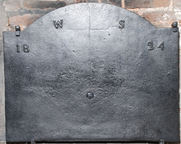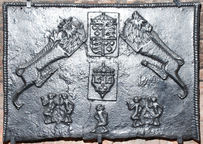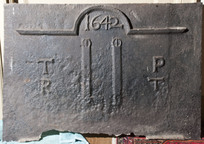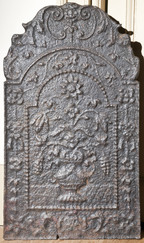-
341
Description: Arched rectangular shaped central panel with ’nutshell,’ paternost edging on a broad fillet; figure of Neptune/Poseidon holding a trident in his right hand, standing on a pedestal in the centre of a circular fountain, with two hippocampi, water issuing from their mouths; in front, a mermaid swims in waves, her arms raised; behind, blasts of wind issue from clouds; arched rectangular border with fillet edging; symmetrical design of seashells suspended from chains of pearls; bottom centre, the monogram between swirled plant tendrils; on top, symmetrical floral swirls.
Notes: Although very similar in size and design to a fireback in the 1724 series, this is not based on a design by Daniel Marot; instead it may have been inspired by the design for a fountain by Jean Lepautre (1618-82) published in a set of 12 etchings by Jean Le Blond in 1650. Almost certainly the 'iron chimney back' purchased by Henry Campion, of Danny, from John Legas for two guineas in 1731; another example, presumably from the same source, is at The Vine, near Basingstoke, Hampshire.
Copies of this fireback are known.
Inscription: SHR
- Decoration tags:
- 'Dutch' (shape)
- fillet (edging)
- whole carved pattern
- pictorial
- architectural
- text
- animals
- humans
- objects
Manufactured: in the early-18th century possibly at Gloucester Furnace, Lamberhurst in the Weald area of England.
Current location: Danny House, Hurstpierpoint, West Sussex, England.
Citation: Brent, C. & J., 2013, Danny House (Chichester, Phillimore), pp. 58-9.
- Attached to series:
- SHR series
- British 'Dutch' style firebacks
-
347
Description: Rectangular; twisted rope edging (top and sides); central Tudor shield, garter, crown and supporters (greyhound and lion), formed from separate stamps; date on a single stamp in top left corner.
Notes: The worn appearance of the central arms, compared with the clarity of the date, suggests that this is an early example of a fireback being used as a pattern, with the addition of a subsequent date. The same stamps forming the arms can also be seen on other firebacks. The extension of the lower part of the ‘3’ on the date stamp suggests that the numbers may have been fixed to the backing block, rather than the date being carved as a whole. Another variant of this fireback (no. 1041) has the rope edging extending only three-quarters of the way down the sides.
Inscription: 1583
Arms: Tudor royal (prob. Elizabeth I)
- Decoration tags:
- rectangular (shape)
- rope (edging)
- carved stamps
- date stamp
- armorial
- royal
- text
Manufactured: in the late-16th century in the Weald area of England.
Current location: Ightham Mote, Ightham, Kent, England.
Museum number: 825358 (part of the National Trust museum group)
-
343
Description: Arched rectangular shape; no edging; initials evenly spaced around arch; date split between top corners.
Inscription: W S / 18 24
- Decoration tags:
- rectangular with round arch (shape)
- none (edging)
- individual letters
- individual numbers
- text
Manufactured: in 1824 in England.
Current location: Ightham Mote, Ightham, Kent, England.
Museum number: 825375 (part of the National Trust museum group)
- Attached to series:
- Date & initials firebacks
-
345
Description: Rectangular; twisted rope edging (top and sides); from top, crowned Tudor royal shield (stamp overpressed) above crowned shield bearing initials, KH in Lombardic lettering, above a fleur de lys (stamp overpressed); to left, diagonal lion passant guardant sinister; to right, diagonal lion passant; at base, single 'imp' figure, arms to side, moving left but facing right, between two pairs of 'imp' figures (separately stamped), one moving left, right arm raised, the other moving right, right arm raised.
Notes: One of the 'Royal' series.
Arms: Tudor royal arms of England
- Decoration tags:
- rectangular (shape)
- rope (edging)
- carved stamps
- heraldic
- armorial
- animals
- humans
Manufactured: in the mid-16th century in the Weald area of England.
Current location: Ightham Mote, Ightham, Kent, England.
Museum number: 825393 (part of the National Trust museum group)
- Attached to series:
- Royal series
-
346
Description: Rectangular with arched rectangular shaped top joined by cavetto curves; astragal edging; shield, supporters, ducal coronet, motto and garter of the Duke of Dorset: Quarterly, Or and gules, a bend vair.
Notes: Almost certainly the arms of Lionel Sackville KG (1688-1765), created first duke of Dorset in 1720.
Copies of this fireback are known.
Inscription: [around shield] HONY SOIT QUI MAL Y PENSE / [on motto scroll] AUT NUNQUAM TENTES, AUT PERFICE
Arms: Lionel Sackville, 1st Duke of Dorset
- Decoration tags:
- rectangular with canted top corners and round arch (shape)
- astragal (edging)
- carved pattern panels
- text
Manufactured: in the early-18th century in the Weald area of England.
Current location: Ightham Mote, Ightham, Kent, England.
Museum number: 825513 (part of the National Trust museum group)
- Attached to series:
- Dorset arms series
- Personal armorial firebacks
- Sackville firebacks
-
352
Description: Arched rectangular shape; cyma curve and astragal edging; fleur de lys formed from acanthus leaves within a circlet, between swirled, budded fronds, all in bas-relief.
Notes: An uncommon English fireback with a purely floral design.
Copies of this fireback are known.
- Decoration tags:
- rectangular with round arch (shape)
- cyma curve and astragal (edging)
- whole carved pattern
- heraldic
- plants
Manufactured: in the mid-17th century in England.
Current location: Christchurch Mansion, Ipswich, Suffolk, England.
(part of the Colchester & Ipswich Museums Service museum group)
- Attached to series:
- Miscellaneous pattern firebacks
-
836
Description: Rectangular with triangular arch; ovolo-moulded edging (top and sides); small stamp of a quartered shield with helm, crest and mantling above the date '1571, initials split either side of shield, repeated six times in two lines of three, the middle stamp of each line higher than the other two.
Notes: The arms may be of the family of Humberston quartered with another; the stamp would have been made specially for the fireback, the date and initials being carved with the arms.
Inscription: I H / 15 71 [repeated 6 times]
Arms: Humberston family
- Decoration tags:
- rectangular with triangular arch (shape)
- ovolo (edging)
- carved stamps
- armorial
- text
Manufactured: in 1571 in the Weald area of England.
Current location: Christchurch Mansion, Ipswich, Suffolk, England.
(part of the Colchester & Ipswich Museums Service museum group)
Citation: Traill, H. D. & Mann, J. S., 1902, Social England vol. III, (London, Cassell), p. 732.
- Attached to series:
- Personal armorial firebacks
- Triangle arch series
-
1104
Description: Rectangular shape; plain edging (top and sides); full-height impression of a fireback of arched rectangular shape and ovolo edging; date in arch; below arch, two parallel straps, each with a buckle at the top; initials T above R to the left of centre, and P above T to the right.
Notes: The side edging of the original fireback has been erased before casting. A variant of the 1642 series of firebacks bearing the Pelham buckle badge and the initials TP, believed to relate to Sir Thomas Pelham (1597-1654). It is not known to whom the initials RT relate; their style suggests they are contemporary with the original fireback. A larger fireback has been created by impressing either the original pattern of the Pelham fireback or a casting from it into a plain rectangular mould, and modifying it by removing the side moulding. It is unclear whether the additional initials, RT, had already been added to the 'pattern' or were added to this casting.
Inscription: 1642 / T P / R T
- Decoration tags:
- rectangular (shape)
- plain and ovolo (edging)
- whole carved pattern
- individual letters
- individual numbers
- planklines
- text
- objects
Manufactured: in the mid-17th century possibly in the Weald area of England.
Current location: in private hands, Isleworth, London, England.
- Attached to series:
- 1642 Pelham series
- Pelham family firebacks
-
1117
Description: Arched rectangular shaped central panel, bead edging, narrow-necked urn with swagged decoration and gadrooned base, flowers issuing therefrom; arched rectangular shaped border with fillet edging and symmetrical floral festoons; on top, mirrored plant fronds descending from a small mask; at the bottom, an indistinct cartouche and a probable letter 'W' between swirled foliage.
Notes: Small firebacks of this type and period might have been cast at one of the London foundries and used for attaching to the rear of dog grates. The initial 'W' probably denotes the pattern maker.
Inscription: W
Manufactured: in the late-17th to early-18th century possibly in the London area of England.
Current location: in private hands, Isleworth, London, England.
- Attached to series:
- British 'Dutch' style firebacks
- W series
-
1118
Description: Rectangular; twisted rope edging (top and sides); initials in top corners; below the initials, a saltire formed of possibly two straight lengths of twisted rope.
Notes: The saltire is likely to have an apotropaic purpose; the hollows in the risers of the letter 'H' and the end of the left line of the saltire may have been formed by gas bubbles in the molten iron during casting.
Inscription: N H
- Decoration tags:
- rectangular (shape)
- rope (edging)
- simple stamps
- individual letters
- apotropaic
- text
Manufactured: in the early- to mid-17th century in England.
Current location: in private hands, Isleworth, London, England.
- Attached to series:
- Rope design firebacks









